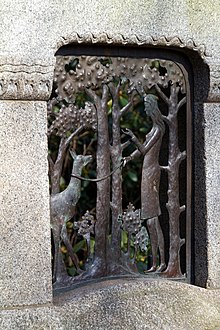Fairy Tale Fountain (Dresden)
The fairy tale fountain is a fountain in the Hermann Seidel Park in the Striesen district of Dresden . The fountain was donated in 1903 by Bruno Hietzig , the then owner of the CG Kunath Granitwerke from Demitz-Thumitz , as part of the German Urban Development Exhibition. The design of the fountain comes from the architects Schilling & Graebner , probably by Paula Hietzig, the wife of the founder. It was originally located on the event site near the Lingner Pavilion. After its completion, it was moved to Johann-Georgen-Allee near today's German Hygiene Museum . In the course of the construction work surrounding the Hygiene Museum, the fountain was moved to today's Hermann-Seidel-Park in 1930 and renovated there in 1991, and the metal work of the Grimm fairy tale about Little Brothers and Sisters, which was lost in 1930, was replaced by a replica .
history
As part of the preparation for the German Urban Development Exhibition in 1903, the owner of the CG Kunath Granite Works in Demitz-Thumitz approached the city to donate a fountain. This foundation should then become finally effective when the fountain can be seen in public space after the exhibition is over. The city of Dresden accepted this foundation.
During the exhibition, this fountain was set up near the Lingner pavilion, in 1904 the city designated the junction of Johann-Georgen-Allee / Prinz-Albrecht-Straße (today Lingnerallee / Blüherstraße) as the installation site. They spent a total of 570 marks on the shipment and installation.
In the course of the redesign of the area around the German Hygiene Museum, it was moved to the Hermann-Seidel-Park (then Volkspark Striesen ) location in 1930 . During this implementation, the metal work of the Grimm fairy tale representation was lost.
During the reconstruction, which took place in 1991, the fairytale depiction was recreated by Peter Bergmann as a driving work from brass and sheet copper based on historical photos, and then re-attached in 1992 as a replica of the original.
description
The fountain, which was created in the Art Nouveau style that was customary at the time, has a relatively rough shape due to the use of granite in the area of the basin. A semicircular water basin merges laterally into benches, each of which ends with depictions of frogs. In the dominant, 2.10 meter high middle section, there is a delicate metal drifting, which shows a scene from the fairy tale Little Brother and Sister of the Brothers Grimm with the girl and his brother who has been transformed into a deer.
The fountain is operated with drinking water and controlled by a small water computer.
Others
- Another fairy tale fountain, the Gorbitz fairy tale fountain , a ceramic work by Karl Schönherr , has been located at the beginning of the Höhenpromenade in Dresden's Gorbitz district since 1986 .
- The “Pension am Märchenbrunnen” is located in the Dresden district of Lockwitz and has nothing to do with either of the fountains; the replica of a draw well on the property is not functional.
See also
literature
- Daniel Jacob: Sculpture Guide . Daniel Jacob, Dresden 2011, ISBN 978-3-942098-05-2 , p. 205.
- Detlef Eilfeld, Jochen Hänsch: The Dresden fountain book - water in its most beautiful form. Volume II, SV Saxonia Verlag, Dresden undated (2016). ISBN 978-3-944210-75-9 , pp. 78-79.
Web links
- Information on the “fairytale fountain” on dresdner-stadtteile.de
- The "fairy tale fountain" (as "little brother and sister fountain", which is not exact) in the Dresden city wiki
Individual evidence
- ^ Daniel Jacob: Sculpture Guide . Daniel Jacob, Dresden 2011, p. 261.
Coordinates: 51 ° 2 ′ 46.6 " N , 13 ° 47 ′ 54.5" E

